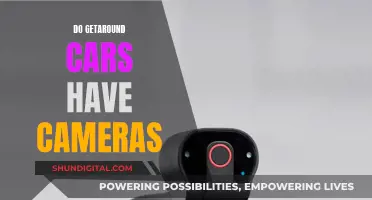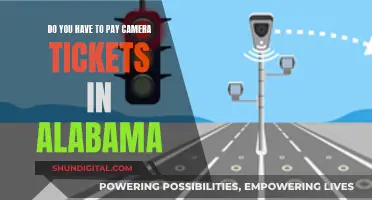
Police cameras are a type of surveillance camera used by law enforcement agencies to monitor public spaces and gather evidence. They can be body-worn cameras or mounted on poles, buildings, or vehicles. While they are meant to improve officer safety and the quality of evidence, their effectiveness is debated, and they raise concerns about privacy and civil liberties. The increasing use of police cameras and advancements in technology have sparked discussions about the need for regulations to protect individuals' rights and personal information.
| Characteristics | Values |
|---|---|
| Purpose | Surveillance, evidence collection, monitoring |
| Users | Police, FBI, local law enforcement agencies |
| Types | Body-worn, pole-mounted, bullet, dome, pan-tilt-zoom (PTZ), thermal, automated license plate readers (ALPR), drones |
| Features | Infrared LEDs, infrared/night vision, tamper-resistant, varifocal lenses, face recognition, license plate recognition, real-time crime monitoring |
| Concerns | Privacy, data retention, community consent, regulation, oversight, data security |
What You'll Learn

Police body-worn cameras
Body-worn cameras have evolved to include features such as high-definition video, night vision, and live-streaming capabilities. They provide an objective account of police encounters, increasing accountability and protecting both the public and officers from false accusations. This technology enhances transparency, allowing the public to witness police operations and decisions, thereby building trust.
The footage captured serves as powerful evidence in legal proceedings, corroborating statements and providing a factual basis for judgments. It also facilitates investigations by offering immediate and detailed accounts of incidents. Additionally, the presence of body-worn cameras positively influences officer behaviour, encouraging adherence to protocols and restraint.
However, the use of body-worn cameras also raises concerns and challenges. Privacy issues are a significant consideration, as recording interactions without consent can infringe on privacy rights. Balancing transparency and privacy is complex and requires robust legal frameworks. Additionally, the implementation of body-worn camera programs entails significant financial investment, with costs associated with hardware acquisition, video storage, and system maintenance.
While body-worn cameras offer benefits, research on their effectiveness is mixed. Some studies suggest positive outcomes, while others show no impact or negative effects. Further research is needed to determine their value and effective deployment methods. The integration of body-worn cameras into policing must carefully navigate the complexities of balancing public safety, transparency, and individual privacy rights.
Abode Streaming Camera: Charging and Power Options
You may want to see also

Police access to private cameras
Private security cameras are increasingly becoming a surveillance tool for police departments, who can gain access to the images through partnerships with private companies. This has raised concerns among civil rights activists, who warn of "mission creep", as cameras installed to prevent break-ins are used to monitor protesters and communities of colour.
In the United States, there are an estimated 50 million closed-circuit TV cameras, many of which are owned by private individuals or companies. Police departments in several cities, including Newark, Baltimore, San Francisco, and Detroit, have some form of public-private camera system in place. While these systems are lauded by police for reducing crime in high-violence neighbourhoods, civil rights activists argue that they often become a system of warrantless surveillance, particularly for communities of colour.
For example, in Detroit, the police department has a project called Project Green Light, where CCTV cameras installed at gas stations stream real-time footage directly to the police, allowing for faster response times and "virtual patrols". However, activists argue that the police use this system for more than just patrolling gas stations and that the resources spent on the project could be better spent elsewhere.
In San Francisco, the police department maintains a database of camera owners and locations and requests footage if they suspect a crime has been committed. While anyone can request the footage, including defence lawyers or filmmakers, the police have obtained real-time access to the entire system during protests, raising concerns about warrantless surveillance.
When it comes to private security cameras in homes or businesses, police generally cannot confiscate or access footage without a warrant or court order. The Fourth Amendment provides protections against unreasonable government searches and seizures without warrants. However, there are exceptions, such as when footage can be viewed from a public space or in cases of immediate crisis or emergency.
When police request security camera footage, it is important to confirm the legitimacy of the request, seek legal advice if unsure, and only provide specific timeframes and clips relevant to the investigation.
The First Camera Image: A Historical Snapshot
You may want to see also

Police use of drones
Police departments across the United States are increasingly turning to drones as a cost-effective and efficient way to enhance their operations and keep their communities safe. Drones are being used by police for a variety of purposes, from search and rescue to crime scene investigation and traffic control.
History of Police Drones
The use of drones in law enforcement was first explored with the development of the Spectra drone by retired US Air Force medic Gene Robinson in 2005. The Spectra drone was created specifically for search and rescue operations and has been used successfully for that purpose hundreds of times. Since then, drones have become an integral part of police operations, with approximately 1,400 police departments in the US utilising them. This number is expected to increase significantly as drones become more accessible and technologically advanced.
Benefits of Police Drones
Drones offer several advantages to law enforcement agencies. They can be deployed quickly and provide valuable aerial reconnaissance, especially in remote and inaccessible areas. This capability is particularly useful in search and rescue operations, where they can locate missing persons using thermal imaging and provide real-time information to search teams on the ground. Drones can also be used to reconstruct accident and crime scenes efficiently, capturing multiple angles and three-dimensional models, which can aid in investigations and provide evidence for legal proceedings.
Additionally, drones can be equipped with various payloads, such as cameras, thermal sensors, loudspeakers, spotlights, and beacons, depending on the mission's specific needs. They are also more cost-effective than traditional aerial support options like helicopters and can be deployed without attracting attention, making them ideal for surveillance and monitoring operations.
Drones as First Responders
One of the most significant developments in police drone usage is their deployment as first responders. In several police departments across the US, drones are now the first unit sent out in response to 911 calls. This approach has proven effective in assessing the situation and determining the appropriate human police response. Drones can provide valuable intelligence that aids in the swift resolution of incidents and ensures the efficient deployment of resources.
Concerns and Criticisms
While police drones offer numerous benefits, their use has also raised concerns about surveillance and privacy. Civil liberty advocates worry that the increasing use of drones by law enforcement may lead to pervasive and suspicionless mass aerial surveillance. There are fears that drones could be used for warrantless surveillance of specific individuals, neighbourhoods, or communities, potentially exacerbating issues of over-policing and targeting of vulnerable groups.
Future of Police Drones
The future of police drone technology lies in autonomous drones. These drones can operate without a human pilot, utilising machine learning, AI, and Micro Air Vehicle Link (MAVLink) technology to detect obstacles, manoeuvre inside buildings, and collaborate with other drones. Autonomous drones will increase response times, reduce costs associated with training, and free up resources for other critical tasks.
Materials Used to Make Camera Mounts
You may want to see also

Police use of automatic license plate readers
Automatic license plate readers (ALPRs) are high-speed, computer-controlled camera systems that are typically mounted on street poles, streetlights, highway overpasses, mobile trailers, or attached to police squad cars. ALPRs can be used to track cars in real time and to track the past locations of cars.
How ALPRs Work
ALPRs automatically capture all license plate numbers that come into view, along with the location, date, and time. The data, which includes photographs of the vehicle and sometimes its driver and passengers, is then uploaded to a central server. Law enforcement agencies can choose to share this information with thousands of other agencies.
Who Uses ALPRs?
ALPRs are used by both private companies and government agencies. Private companies use ALPRs to locate cars and perform investigations. Government agencies, including police departments, use ALPRs to conduct dragnet surveillance of motorists.
Benefits of ALPRs
ALPRs have been shown to increase the recovery of stolen vehicles by 50%. They can also aid in the rapid alerting of Amber and Silver Alerts and can assist in monitoring traffic flow and aid in the efficient management of roadways.
Concerns About ALPRs
The increasing deployment of ALPRs has raised concerns about privacy and data security. The ACLU has called for the adoption of legislation and law enforcement agency policies to address these concerns. Specifically, the ACLU recommends that:
- License plate readers may be used by law enforcement agencies only to investigate hits and in other circumstances in which law enforcement agents reasonably believe that the plate data is relevant to an ongoing criminal investigation.
- The government must not store data about innocent people for any lengthy period. Unless plate data has been flagged, retention periods should be measured in days or weeks, not months or years.
- People should be able to find out if plate data of vehicles registered to them is contained in a law enforcement agency’s database.
- Law enforcement agencies should not share license plate reader data with third parties that do not follow proper retention and access principles.
- Any entity that uses license plate readers should be required to report its usage publicly on at least an annual basis.
The Cost of Capturing Moments: Camera Charging Explained
You may want to see also

Police use of predictive policing programs
Predictive policing is a law enforcement strategy that uses mathematical models, predictive analytics, and other analytical techniques to identify potential criminal activity. It involves collecting and analyzing data about previous crimes to make statistical predictions about future crimes. These predictions are used to develop policing intervention and prevention strategies. While proponents argue that it can help law enforcement agencies deploy their resources more efficiently and effectively, there are also concerns and criticisms regarding the ethical implications and limitations of these programs.
Benefits of Predictive Policing
Proponents of predictive policing argue that it can enhance traditional policing methods by providing valuable insights for strategic and tactical planning. By analyzing historical crime data and other relevant information, law enforcement agencies can identify patterns and trends to predict future criminal activities. This enables police departments to optimize their resource allocation, such as determining patrol routes and sectors, and make more informed decisions.
For example, the New York Police Department (NYPD) implemented a predictive policing program that resulted in a 6% decrease in the overall crime index. The NYPD used a combination of video analysis, environmental sensors, license plate readers, 911-feed, and acoustic correlation processing of gunshots to enhance their crime-fighting capabilities.
Another benefit of predictive policing is its potential to prevent crimes by addressing underlying factors. The "AI Ethics of Care" approach recognizes that negative environmental conditions can contribute to higher crime rates. By using artificial intelligence, police can identify these conditions and take proactive measures to minimize crime.
Drawbacks and Criticisms of Predictive Policing
Despite its potential benefits, predictive policing has also faced several drawbacks and criticisms. One of the main concerns is the lack of transparency and understanding of the predictive models used. Law enforcement agencies may struggle to fully comprehend the algorithms and the factors that lead to increased crime risks, impacting the effectiveness of their strategies.
Additionally, predictive policing models have been criticized for their potential to reinforce existing racial biases in the criminal justice system. If the data used to train the algorithms is influenced by discriminatory policing practices or biased crime statistics, the predictions may perpetuate over-policing of minority or low-income communities. This can lead to stigmatization and discrimination against certain individuals or groups.
Furthermore, there are constitutional concerns regarding predictive policing. Some legal experts argue that these programs could threaten rights protected by the Fourth Amendment, which requires "reasonable suspicion" for police stops. Predictive analytics may lower the threshold for "reasonable suspicion," resulting in more stops and potentially infringing on civil liberties.
Another criticism of predictive policing is the potential invasion of privacy. As predictive policing relies on collecting and analyzing vast amounts of data, there are questions about the boundaries of digital privacy and the protection of citizens' digital footprints.
In conclusion, while predictive policing offers a new approach to law enforcement, it is essential to carefully consider its ethical implications and limitations. Addressing these concerns through thorough evaluation, transparency, and community involvement is crucial to ensuring that predictive policing programs are effective, unbiased, and respectful of civil rights and liberties.
Cleaning Corroded Camera Battery Terminals: DIY Guide
You may want to see also
Frequently asked questions
Police cameras are surveillance tools used by police departments to monitor public spaces. These include body-worn cameras, fixed cameras on traffic lights or poles, and mobile surveillance units such as manned towers or trailers with pan-tilt-zoom (PTZ) cameras.
Police departments argue that surveillance cameras help reduce crime and improve officer safety. They are also used to collect evidence, reduce civilian complaints, and lower agency liability.
The effectiveness of police surveillance cameras is debated. While some studies suggest potential benefits, others show no significant impact or even negative effects. More research is needed to determine their effectiveness, particularly regarding civil liberties and privacy concerns.
There are concerns about privacy, civil liberties, and the lack of regulation surrounding police surveillance cameras. The collection and retention of personal data, the potential for unwarranted spying, and the integration with other surveillance technologies raise serious questions. Additionally, the cost of acquiring and maintaining these systems can be a significant disincentive for law enforcement agencies.







